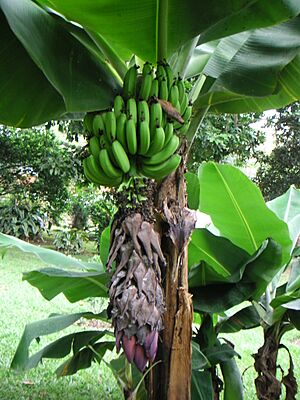Banana production in Honduras facts for kids
Bananas are super important for Honduras's economy. In 1992, selling bananas brought in $287 million. Bananas and coffee together made up half of all things Honduras sold to other countries. In 1999, Honduras grew a huge 861,000 tons of bananas. Two big companies, Chiquita Brands International and the Dole Food Company, grow and export most of Honduras's bananas.
Contents
How Bananas Became a Big Business
Honduras started selling bananas to other countries in the late 1800s. This business grew really fast!
Early Banana Farms
At first, in the 1870s, most bananas came from the Bay Islands. But by 1880, serious growing began on the mainland. By 1894, Honduras sold almost $350,000 worth of goods to the United States through Puerto Cortés, a main port. By 1903, this jumped to over $900,000! Most of this growth was from bananas. Between 1894 and 1903, banana sales grew almost four times.
More ships also started sailing. They went from four ships a month to the US to 18 ships. The bananas went to more US cities too, like New Orleans, Mobile, Philadelphia, and Boston.
Local Growers and Big Companies
At first, local farmers grew most of the bananas. A count in 1899 showed over 1,000 people in northern Honduras grew bananas. Most of them had small farms. These farmers were able to grow more bananas. They also gained control of land from cattle ranchers.
In the early days, banana growers took their fruit to the coast. There, ships from different US companies bought them. But over time, these shipping companies joined together. Soon, only a few were left. The Vaccaro brothers from New Orleans became very powerful. In 1899, they started the Standard Fruit and Steamship Company, which later became Dole.
Building Railroads for Bananas
Northern Honduras did not have good roads or ways to transport goods. So, only farms near big rivers or existing railroads could easily sell their bananas. The shipping companies needed to build railroads. This would help them reach more farms and grow more bananas. By 1902, new railroad lines were being built along the Caribbean coast. These lines helped move the growing banana crops.
Land Deals and US Companies
The Honduran government had rules to help farming grow. They gave away land and didn't make companies pay taxes. This was for anyone who would start farming new land. Some Honduran farmers used these chances. But the biggest deals went to US companies. These companies had enough money to buy and develop land quickly.
For example, the Tela Railroad Company got land deals for building railroads. In 1912, they received 6,000 hectares (about 15,000 acres) of land for every 12 kilometers (about 7.5 miles) of track they built. This land was given in blocks along both sides of the railroad lines.
After these deals in 1912, US companies controlled most of the good farming land on Honduras's Atlantic coast. The Cuyamel Fruit Company controlled the area around Puerto Cortés. Standard Fruit controlled the La Ceiba region. And United Fruit Company controlled Tela and Trujillo through its companies, the Tela Railroad Company and the Trujillo Railroad Company. By 1929, the United Fruit Company operated on over 650,000 acres of land in Honduras. They also controlled the main ports.
Banana Diseases
At first, Honduran farmers grew a banana called Gros Michel. This type of banana was easy to store and ship. People in North America liked it. However, in the early 1920s, banana farms started getting a disease called "Panama Disease." Also, growing only one type of crop made the soil tired. These problems caused banana production to drop in northern Honduras.
The companies tried to fix this. They built new railroads and made new land deals. This helped them use fresh land for growing. They also started growing a new type of banana called Cavendish. This banana could resist the disease better.


